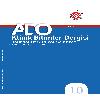F6 GENERASYONUNDA PAMUK (Gossypium. hirsutum L.) DÖL SIRALARININ SU STRESINE KARŞI TEPKILERININ BELIRLENMESİ
Bu çalışma, F6 generasyonunda bulunan tek bitki pamuk (Gossypium hirsutum L.) döl sıralarının su stresinetepkilerini belirlemek amacıyla 2015 yılında Adnan Menderes Üniversitesi Ziraat Fakültesi deneme alanındadamlama sulama yönteminin uygulandığı kısıtlı sulama (%50) koşullarında yürütülmüştür. Çalışma, melezkombinasyonlar, kontrol çeşitler (BA 308, Gloria, Carmen, Claudia ve Elsa) birer sıra ve sıra uzunluğu 12 rnolacak şekilde Agumented deneme deseninde dört tekerrürlü olacak şekilde kurulmuştur. Varyans analizsonucunda; kısıtlı sulama koşullarında incelenen tüm özellikler bakımından genotipik farklılığın önemli olduğusaptanmıştır. F6 generasyonunda kısıtlı sulama koşullarında yetiştirilen pamuk melez döl sıraları verim ve lifkalite özellikleri bakımından değerlendirildiğinde; GSN-12 NlAB-l 11 (sıra no: 78), STN-453 Tamcot 22(sıra no: 94), GSN-12 NlAB- 11 (sıra no: 100), BA-119 Eva (sıra no: 97), Carmen Eva (sıra no: 12), CarmenNlAB-l 11 (sıra no: 99) ve BA-119 Eva (sıra no: 93) melez döl sıralarının su stresine dayanıklı veya tolerantolduğu saptanmıştır.
Determinatıon the Response of Cotton (Gossypı'um hirsutum L.) Hybrid Populations to Water Stress at F6 Generation
This study was carried out at Experiment fields ofAdnan Menderes University, Faculty ofAgriculture under dripirrigation system to determine the response of cotton hybrid populations to water stress at generation. Thisstudy was conducted under water stress (50%: deficit irrigation) conditions with Augmented experiment designwith four replications. Each cross and control varieties (BA 308, Gloria, Carmen, Claudia ve Elsa) was plantedone row and 12 in 2015. Variance analysis showed that the response of cotton lines (genotype) to deficitirrigation was significant for all investigated traits. The result ofthe study showed that in F6 generation; GSN-12NlAB-l 11 (line no: 78), STN-453 Tamcot 22 (line no: 94), GSN-12 NlAB-l 11 (line no: 100), BA-119 Eva(line no: 97) and Carmen Eva (line no: 12), Carmen NlAB-l 11 (line no: 99) ve BA-119 Eva (line no: 93) areAraştırma Researchdrought resistant or tolerant hybrid populations.
___
- Ball RA, Oosterhuis DM, Mauromoustakos (1994) Growth dynamics of the cotton plant during waterdeficit stress. Agron.J., 86: 788-795.
- Basal H, Bebeli P, Smith CW, Thaxton (2003) Root growth parameters of converted racestocks of upland cotton (G. hirsutıım L.) and two BC2F2 populations. CropSci.,43:l983-l988.
- Basal H, Smith CW, Thaxton PS, Hemphill JK (2005) Seedling drought tolerance in upland cotton (G. hirsutum L.) CropSci., 45 (2), 766-771.
- Basal H, Dagdelen N, Unay A, Yılmaz (2009) Effects of deficit drip irrigation ratios on cotton (Gossypiıım hirsutıım L.) yield and fiber quality. J. Agron. Crop Sci., 195: 19-29.
- Bland WL, Dugas WA (1989) Cotton root growth and soil water extraction. Soc.Am. J. SoilSci., 53:1850-1855.
- Dagdelen N, Basal H, Yilmaz E, Gurbuz T, Akcay (2009) Different drip irrigation regimes affect cotton yield, water use efficiency and fiber quality in western Turkey. Agricultural Water Management, 96; (1) 111- 120.
- Howell TA, Hiler EA (1975) Optimization of water use efficiency under high frequency irrigation 1. Evapotranspiration and yield relationship. Transactions oftheASAE, Vol, 18, No. 5.
- Howard DD, Gwathney CO, Lessman GM, Roberts RK (2001) ertilizeradditive rate and plant growth regulator effects on cotton. J. CottonSci., 5:42-52.
- Johnson RM, Downer RG, Bradow JM, Bauer PJ, Sadler EJ (2002) Variability in cotton fiber yield, fiber quality, and soil properties in southeastern coastalplain. Agron. J., 94,1305-1316.
- Krieg DR (1997) Genetic and environmental factors affecting productivity of cotton. Proc. BeltwideCottonProd. Res. Conf. p: 1347.
- Leidi EO, Lopez M, Gorham J, Gutierrez JC (1999) Variation in carbon isotope discrimination and other traits to drought tolerance in upland cotton cultivars under dry land co nditions. Field Crops Res., 61: 109- 123. McWilliams (2004) Drought strategies for cotton. Cooperative Extension Service Circular 582 College of Agricultureand Home Economics. http://www.cahe.nmsu.edu/pubs/circulars. Son erişim tarihi: 15 Ekim 2011.
- Mert (2005) Irrigation of cotton cultivars improves seed cotton yield. yield components and fibre properties in the Hatay region, Turkey. Acta Agriculturae Scandinavica, B,. 55: 44-50.
- Pace PF, Cralle HT, El-Halawany SHM, Cothren JT, Senseman SA (1999) Drought-induced changes in shoot and root growth of young cotton plants. Cotton Sci. 3:183-187.
- Pettigrew WT (2004) Moisture deficit effect on cotton lint yield, yield components, and boll distribution. Agron. J.,96,377—383.
- Ritchie GL, Bednarz CW, Jost PH, Brown SM (2004) Cotton growth and development. Cooperative Extension Service and The University of Georgia College of Agricultural and Environmental Sciences. Bulletin, 1252.
- Shakoor MS, Malik TA, Azhar FM, Saleem MF (2010) Genetics of agronomic and fiber traits in upland cotton under drought stress. lnt. J. Agric. Biol., 12: 495—500. 70
- Türkeş (2008) Gözlenen iklim değişiklikleri vekuraklık: Nedenleri ve geleceği. Toplum ve Hekim, 23:97-107.
- Xu X, Taylor HM (1992) Increase in drough tresistance of cotton seedling treated with Mepiquat Chloride. Agron. J., 84:569-574.
- ISSN: 1304-7787
- Yayın Aralığı: Yılda 2 Sayı
- Başlangıç: 2004
- Yayıncı: Adnan Üniv. Ziraat Fak.
Sayıdaki Diğer Makaleler
SU ÜRÜNLERİNDE KULLANILAN ANESTEZİKLER
Deniz ÇOBAN, Semra KÜÇÜK, Sema ÖZTÜRK
AYDIN'DA KARASU SORUNU ve ZEYTİNYAĞI İŞLETMELERİNİN ÇÖZÜME YÖNELİK TERCİHLERİNİN İNCELENMESİ
SİMMENTAL YETİŞTİRİCİLİĞİNİN_DEĞERLENDİRILMESİ: 1. DÜNYADA ve TURKIYE'DEKI YETIŞTIRICILIGİ
TALİH GÜRBÜZ, HÜSEYİN BAŞAL, HATİCE KÜBRA GÖREN
Comparative Advantage of Turkey in Apple Exports
TÜRKİYE'DE GIDA GÜVENCESİNİN MEVCUT DURUMUNUN DEĞERLENDİRİLMESİ
AYDIN İLİ YERALTI SULARININ HAYVANCILIK İÇİN İÇME SUYU KALİTESİ BAKIMINDAN DEGERLENDIRMESI
